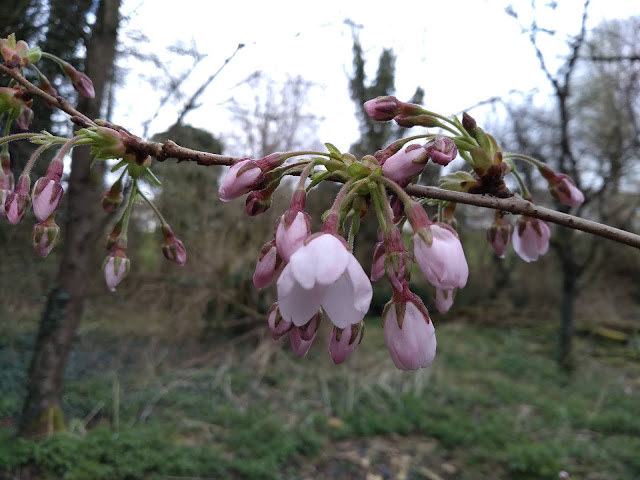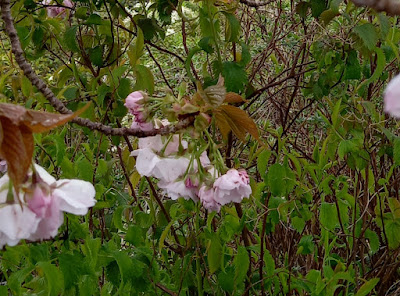Narayan was born in Madras (Chennai),
though the setting for his fictions (“Malgudi”) is based on Mysore
and Bangalore.
One of my favourites is ”Emden” (the final story in Malgudi Days (1943)), a tale of extreme old age. Its hero
Rao, we gather, was not an amiable man in his prime; corrupt, fearsome, and
very successful. At the present time, however, he is any old man, struggling
with a failing memory and winding cautiously through an existence (for his few
good hours per day) whose features are invisible to those around him. Rao is so
old that he no longer recognizes the names in the obituaries. A disgrace ended
his career, and changed his relationship to his own past. Now he has a daily
routine that involves reading a daily newspaper column on religious matters,
“adequate for him to brush up his thoughts on God”, and taking a very careful
walk.Though the story is full of dust and silence, time is not passing
ferociously; it has stopped.
In the story his self-imposed adventure consists of a futile
search for a place where, half a century before, he behaved badly to a woman
(S. in his diary). He would like to bring her some sweets (he is unable to
grasp just how long ago everything is, and we know that he imagines her coming
to him, still plump and jasmine-smelling, like a girlfriend abandoned “years
ago” but basically unchanged). Eventually a dog scares him and he drops the jilebi;
the mongrel takes them off, gratefully wagging his tail. He muses: “Who knows,
S. is perhaps in this incarnation now...”
Rao’s transactions with others are, to say the least,
limited. He is not sure of any names and can hardly hear. He is not interested
in what they have to say, anyway; his own questions are on the edge of
meaninglessness.
And then a young shop assistant came out to take his
order. Rao looked down at him and asked, pointing at the cross street, “Where
does it lead?”
“To the next street,” the boy said, and that somehow
satisfied him. The boy asked, “What can I get you?”
“Oh, will no-one leave me alone?” Rao thought with
irritation.
He is immensely alone. Nevertheless, he buys some sandalwood
soap, and then he decides that S. must have smelt of sandalwood, not jasmine.
Rao, we assume, gets home. He will not remember this day,
nor will anyone else. “Nevertheless” may represent our overall response to the
story, though that places all the emphasis on what Rao still retains, not on
what he may now have; in other words it accepts certain assumptions connected
with the word “decay”. Rao still somehow registers the world – (The word
“somehow” is a key one in the story, representing certain mental gaps.) He is
not Alzheimered though he might be doting. Our vocabulary for these far steps is
poor.
Narayan uses comedy as a highly complex illuminating
instrument. Young people laugh, old people are funny. I don’t know why old
people laugh so seldom, and can hardly even smile for a camera; they lose,
obviously, the vanity-aspect of this display, for smiling is a communication,
it is not frequently completely spontaneous. Rao’s internal commentary is sharp
and spiced, but with only the ghost of humour; “nevertheless” he relishes,
enjoys and becomes excited in his circumscribed way.
I want to run jostling through the rain, and I do. If I ever
find any pages that are more eloquent about those last stages of life that we
may reasonably hope for without enthusiasm, and tremulously observe in others,
then I’ll mention it here.
The other stories I like best are “The
Evening Gift”, “Selvi” and “Lawley
Road”. Like “Emden”
they operate as spotlights if you let them.
Ashokamitran: Water (1971)
Ashokamitran (b. 1931) is a Tamil author. Tannir was
serialized in 1971; it is set during the 1969 drought in Madras (Chennai). The English translation was by
Lakshmi Holmström (Heinemann, 1993).
That sentence about the drought gave me some disquiet. I
could also say, with no less disquiet, that it’s the story of Jamuna and her
younger sister Chaya, two women in various sorts of trouble. What’s striking
about Water – a sort of novella-length short story – is how it deviates
from the expectations aroused by these literally true descriptions. It does not
seem to be concerned with its subjects in quite the expected way – it leaves
spaces, is not quite pinned down and not by a second reading either.
Substantial scenes are devoted to other, unnamed characters. The author has
said that he began only with an image of a girl carrying a water-pot, and that
enigmatic and steady image seems to be always present, no matter what we’re
reading. Water does not entirely cast itself adrift in narrative.
Ashokamitran’s prose is plain to the point where you have to
deal with it. Bhaskar Rao, Jamuna’s lover, comes to take her out. Chaya arrives
soon after; she disapproves very strongly.
Jamuna handed Bhaskar Rao a cup of tea, placed
another cup on the table and then went to the stove and blew it out. Chaya
helped herself to a single brass chembu of water and left the room. Bhaskar Rao
drew a long breath and looked intently at Jamuna. Jamuna avoided his gaze. When
she caught his eye by chance after some time, he signalled to her, ‘Go on, get
ready.’ Jamuna took hold of another small chembu by its narrow neck and dipped
it into the water, filling it just half full. Chaya came in then, her wet hair
clinging to her forehead. Jamuna went out of the room, taking her own vessel
with her. Chaya immediately placed her chembu beside the buckets and left the
room as well. Jamuna came back into the main room, having used her half chembu
of water with extreme care, contriving to wash her hands and feet as well as
her face. Bhaskar was standing up by this time, impatient, having finished his
tea. When he saw Jamuna, he said softly, but with grim determination, ‘Get
ready’. Jamuna wiped her face and opened her trunk. At that moment Chaya too
returned to the room and began to drink the tea that Jamuna had left for her on
the table.
It’s through Bhaskar, desperate to get away, that we
experience the unpleasant tension that comes through these neutral-sounding
stage directions. At the same time we are completely aware of Jamuna’s submissive/determined
awareness of her sister, the meaning of the tea on the table (remember we share
our life here just as usual, Chaya, please don’t walk out on me), the meaning
of Chaya being so quickly not in the room (I wash my hands of you, my routine is
not disturbed) and back in it (I have a right to be here, and you know what I
think, are you mad enough to ride roughshod over me). And there’s the
so-limited water, not a literary symbol of the author’s contriving, but a de
facto symbol that everyone in Madras
can’t help appreciating – it therefore becomes a prop in human communication.
Drawing a little more, or drawing a little less, these are automatically
eloquent, in fact it’s impossible not to mean something.
The scene inevitably slides downhill. Water has a
good many ugly, powerful scenes like this. With only the faintest shift of
emphasis Ashokamitran can also use almost the same technique to make episodes
that, we decide, are funny. The later nocturnal scene when the rain is coming
down, and an unnamed husband and wife wrangle about filling just one or two
more containers, is like a jauntier setting of the earlier melody.
With the rain pouring off the ribs of his umbrella,
he returned to his rooms. Immediately his wife asked, ‘Why couldn’t you leave
this one somewhere as well?’
‘I was only able to find a place for one of the
tins.’
‘It must be full by now. Go and fetch it.’
He hesitated for a moment. Then he opened his
umbrella and started out again.
‘While you are about it, why don’t you take this one
along as well? When you bring that tin away, you could put this one in its
place.’
‘Go and get rid of it yourself.’ He flung his
umbrella towards the tin. Being already open, it fell elsewhere, swaying a
little.
That recalcitrance of the umbrella’s flight makes it one of
a sequence of objects whose motion is hard to control. The taxi, after the
driver pulls over in a street where the streetlights have failed, slipping into
an open ditch :
There was a sudden strange noise. After that the car
moved, as if of its own volition, still further to the left. Then it came to a
standstill with a sharp grinding sound.
Or Jamuna’s mother in her dreadful bed:
He lifted Jamuna’s mother a little, standing behind
her shoulders. Jamuna peeled away the sari and removed it together with the
sacking. She wiped her mother’s waist and thighs. Swiftly Chaya wrapped the
fresh sari around their mother. Then the older woman fell back heavily, on to
the bed.
Through the spaces in the text you are still aware of the pot-carrier,
clambering over walls, edging her water pot under a communal tap.
[More gleanings from my former website: I wrote these two notes back in c. 2006.]
Labels: Ashokamitran, R.K. Narayan























































